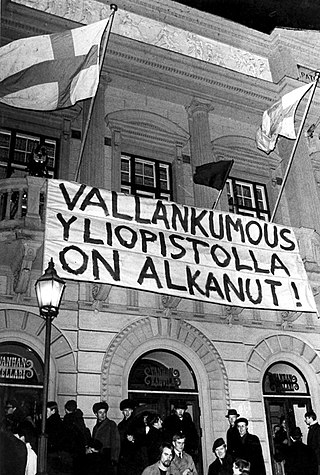
Kauniainen is a town in Finland, located in the southern interior of the country. Kauniainen is situated in the southern part of the Uusimaa region, and it is enclaved by the City of Espoo. The population of Kauniainen is approximately 10,000. It is the 94th most populous municipality in Finland. Kaunianen is part of the Helsinki Metropolitan Area, which has approximately 1.6 million inhabitants.

Pirkanmaa, also known as Tampere Region in government documents, is a region of Finland. It borders the regions of Satakunta, South Ostrobothnia, Central Finland, Päijät-Häme, Kanta-Häme and Southwest Finland. Most of the water area in the Kokemäki River watershed is located in the Pirkanmaa region, although Lake Vanajavesi is partly in the Kanta-Häme region. The region got its name from Pirkkala, which in the Middle Ages comprised most of present-day Pirkanmaa. Tampere is the regional center and capital of Pirkanmaa, and at the same time the largest city in the region.

The two main official languages of Finland are Finnish and Swedish. There are also several official minority languages: three variants of Sami, as well as Romani, Finnish Sign Language, Finland-Swedish Sign Language and Karelian.

Chile–Finland relations are foreign relations between Chile and Finland. Chile recognised Finland's independence on June 17, 1919. Diplomatic relations between them were established in 1931 and have been continuously maintained, despite pressures at times to discontinue them. The two countries maintain resident ambassadors in both capitals.

Immigration to Finland is the process by which people migrate to Finland to reside in the country. Some, but not all, become Finnish citizens. Immigration has been a major source of population growth and cultural change throughout much of the history of Finland. The economic, social, and political aspects of immigration have caused controversy regarding ethnicity, economic benefits, jobs for non-immigrants, settlement patterns, impact on upward social mobility, crime, and voting behaviour.

Eastern Lapland is a subdivision of Finnish Lapland and one of the sub-regions of Finland since 2009.
Irreligion in Finland: according to Statistics Finland in 2020, 29.4% of the population in Finland were non-religious, or about 1,628,000 people. The Union of Freethinkers of Finland and other organisations have acted as interest organisations, legal protection organisations and cultural organisations for non-religious people. In a 2018 international ISSP survey, 40% of the Finnish population said they did not believe in God, 34% said they believed in God and 26% did not know. Nearly one out of every five people in the country is not a member of a religious organisation, and the number of people with no religious affiliation has doubled in two decades.

The takeover of Vanha was an uprising by a number of students on November 25, 1968, at the Old Student House of the University of Helsinki in Finland. It occurred on the night of the 100th birthday of the university's student union. The rioters took over Vanha during the celebrations, demanding changes to the university's administration and the curriculum.
Estonians in Finland or Finnish Estonians are people with an Estonian background residing in Finland. In 2023, according to Statistics Finland, there were 52,593 Estonian-background residents in Finland. In 2023, Estonian was the native tongue for 0.9% of Finland's population.
Tapani Kaarle Heikinpoika Brotherus is a Finnish diplomat who was acting as Finnish Chargé d'affaires in Chile during the 1973 coup d'état led by General Augusto Pinochet. Brotherus saved hundreds of Chilean dissidents from death during the coup.
Finnish national symbols are natural symbols or Finnish national works and prominent figures that are commonly associated with Finland. The most recognized national symbols include the flag of Finland and the lion featured on the Finnish coat of arms.
Hoho is one of the smallest villages in the municipality of Laukaa in Keski-Suomi, Finland, near Lievestuore village. The population of the village in 2020 was 186. Hoho and Metsolahti are the southernmost villages of Laukaa. Hoho's name comes from the Hoho river that flows through the village to lake Lievestuoreenjärvi. The most famous person of Hoho was Sylvi Saimo, who was an Olympic gold medalist in canoeing and a politician. Hoho had its own school until 2001.
Norwegians in Finland are immigrants born in Norway, citizens of Norway or speakers of the Norwegian language living in Finland.
Dutch people in Finland are immigrants from the Netherlands living in Finland. They numbered around 2,000 in 2017 and live mainly in the cities of Helsinki and Espoo.

Italian Finns are Finnish-born citizens who are fully or partially of Italian descent, whose ancestors were Italians who emigrated to Finland during the Italian diaspora, or Italian-born people in Finland.
Finnish Iranians or Iranian Finns or Iranians in Finland are Finns of Iranian heritage.

Sälinkää is a village in the Mäntsälä municipality in Uusimaa, Finland, with over 200 inhabitants. It is located 11 kilometres (6.8 mi) northwest of the Mäntsälä's municipal centre and 17 kilometres (11 mi) southeast of Oitti, the municipal centre of Hausjärvi. The north-south road 1471 from Hausjärvi to Mäntsälä passes through the village. Lake Kilpijärvi is located near Sälinkää.

Numminen is a village in the southern part of the Mäntsälä municipality near the border of Pornainen in Uusimaa, Finland. More than 300 inhabitants live in the village. It is located along the Mustijoki River, about 10 kilometres (6.2 mi) south of the Mäntsälä's municipal centre and about 12 kilometres (7.5 mi) northwest of Kirveskoski, the municipal centre of Pornainen.

Vesanka is a village and a district of the city of Jyväskylä, in Central Finland. Before 2009, it was one of the villages of Jyväskylän maalaiskunta. It is located in the far western part of Jyväskylä near its borders with Petäjävesi, Muurame and, until 2009, Korpilahti.













